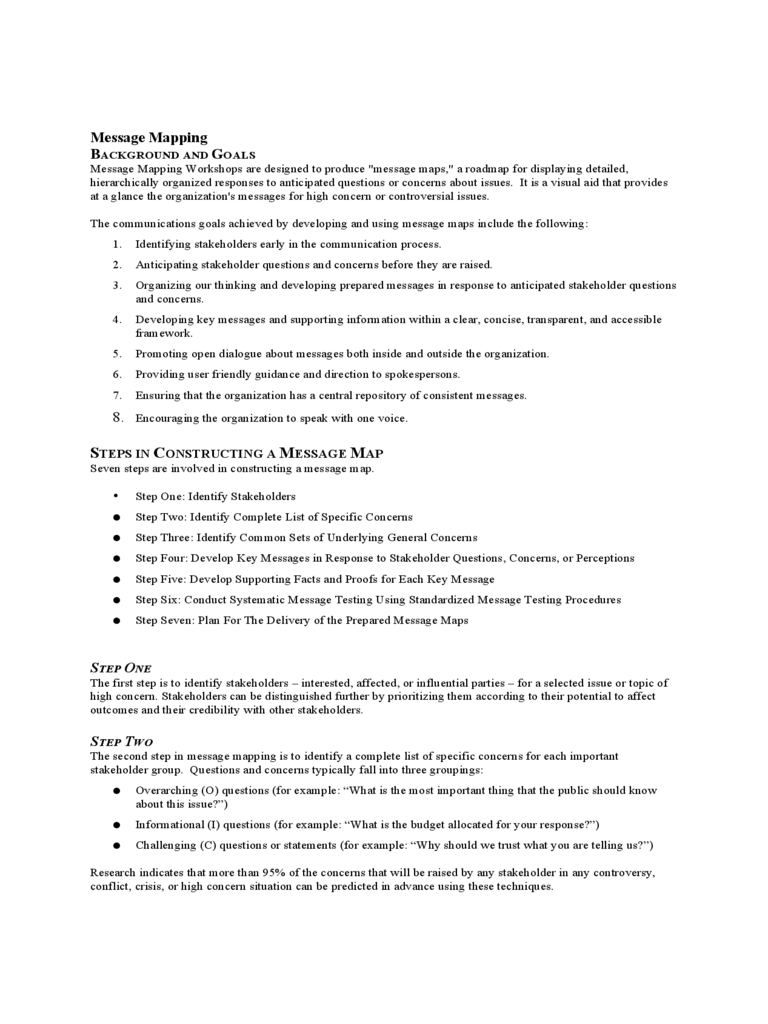Fillable Printable Message Mapping Guidelines
Fillable Printable Message Mapping Guidelines

Message Mapping Guidelines
Message Mapping
BACKGROUND AND GOALS
Message Mapping Workshops are designed to produce "message maps," a roadmap for displaying detailed,
hierarchically organized responses to anticipated questions or concerns about issues. It is a visual aid that provides
at a glance the organization's messages for high concern or controversial issues.
The communications goals achieved by developing and using message maps include the following:
1. Identifying stakeholders early in the communication process.
2. Anticipating stakeholder questions and concerns before they are raised.
3. Organizing our thinking and developing prepared messages in response to anticipated stakeholder questions
and concerns.
4. Developing key messages and supporting information within a clear, concise, transparent, and accessible
framework.
5. Promoting open dialogue about messages both inside and outside the organization.
6. Providing user friendly guidance and direction to spokespersons.
7. Ensuring that the organization has a central repository of consistent messages.
8. Encouraging the organization to speak with one voice.
STEPS IN CONSTRUCTING A MESSAGE MAP
Seven steps are involved in constructing a message map.
• Step One: Identify Stakeholders
● Step Two: Identify Complete List of Specific Concerns
● Step Three: Identify Common Sets of Underlying General Concerns
● Step Four: Develop Key Messages in Response to Stakeholder Questions, Concerns, or Perceptions
● Step Five: Develop Supporting Facts and Proofs for Each Key Message
● Step Six: Conduct Systematic Message Testing Using Standardized Message Testing Procedures
● Step Seven: Plan For The Delivery of the Prepared Message Maps
STEP ONE
The first step is to identify stakeholders – interested, affected, or influential parties – for a selected issue or topic of
high concern. Stakeholders can be distinguished further by prioritizing them according to their potential to affect
outcomes and their credibility with other stakeholders.
STEP TWO
The second step in message mapping is to identify a complete list of specific concerns for each important
stakeholder group. Questions and concerns typically fall into three groupings:
● Overarching (O) questions (for example: “What is the most important thing that the public should know
about this issue?”)
● Informational (I) questions (for example: “What is the budget allocated for your response?”)
● Challenging (C) questions or statements (for example: “Why should we trust what you are telling us?”)
Research indicates that more than 95% of the concerns that will be raised by any stakeholder in any controversy,
conflict, crisis, or high concern situation can be predicted in advance using these techniques.

STEP THREE
The third step in message map construction is to analyze the lists of specific concerns to identify common sets of
underlying general concerns. Case studies indicate that most high concern issues are associated with no more than
15-25 primary underlying general concerns.
STEP FOUR
The fourth step in message map construction is to develop key messages in response to stakeholder question,
concern, or perception. An example is provided below.
1
Sample Message Map
Stakeholder: General Public
Question: How contagious is smallpox?
Key Message 1
Key Message 2
Key Message 3
Smallpox spreads slowly compared
to measles and flu.
This allows time to trace those who
have come in contact.
Vaccination shortly after contact
will generally prevent disease
Supporting Fact 1-1
Supporting Fact 2-1
Supporting Fact 3-1
People are only infectious when
the rash appears.
The incubation period for the
disease is 10-14 days
People who have never been
vaccinated are the most important
to vaccinate
Supporting Fact 1-2
Supporting Fact 2-2
Supporting Fact 3-2
Smallpox requires hours of face-to-
face contact
Resources are available for tracing
contacts.
Adults who were vaccinated as
children may still have some
immunity.
Supporting Fact 1-3
Supporting Fact 2-3
Supporting Fact 3-3
There are no carriers without
symptoms
Finding people who have been
exposed and vaccinating them has
proved successful.
Adequate vaccine is on-hand.
Key messages are typically developed through brainstorming sessions with a message mapping team. As noted
above, the message mapping team typically consists of a subject matter expert, a communication specialist, a
policy/legal/ management expert, and a facilitator.
The brainstorming session produces message narratives -- usually in the form of complete sentences -- which are
entered as key messages onto the message map. Alternatively, the brainstorming session produces keywords for
each message, which are entered onto the message map. Keywords serve as an aid to memory. Each separate
message should have no more than 1-3 keywords.
Key messages should be based on what the target audience most needs to know and most want to know.
STEP FIVE
The fifth step in message map construction is to develop supporting facts and proofs for each key message. The
same principles that guide key message construction should guide the development of supporting information. Proof
points are not necessarily included in the message map. Some may be held in reserve to support a particular message
is challenged.
1
This message map is an example only.
STEP SIX
The sixth step in message map construction is to conduct systematic message testing using standardized message
testing procedures. Message testing should begin by asking subject matter experts not directly involved in the
original message mapping process to validate the accuracy of technical information contained in the message map.
Message testing should then be done with (1) surrogates for key internal and external target audiences and (2)
partner organizations.
Sharing and testing messages with partners ensures message consistency and coordination.
STEP SEVEN
The seventh, and final step, is to plan for the delivery of the prepared message maps through: (1) a trained
spokesperson; (2) appropriate communication channels; and (3) trusted individuals or organizations.
Once developed, message maps can be used to structure press conferences, media interviews, information forums
and exchanges, public meetings, web sites, telephone hot line scripts, and fact sheets or brochures focused on
frequently asked questions.



